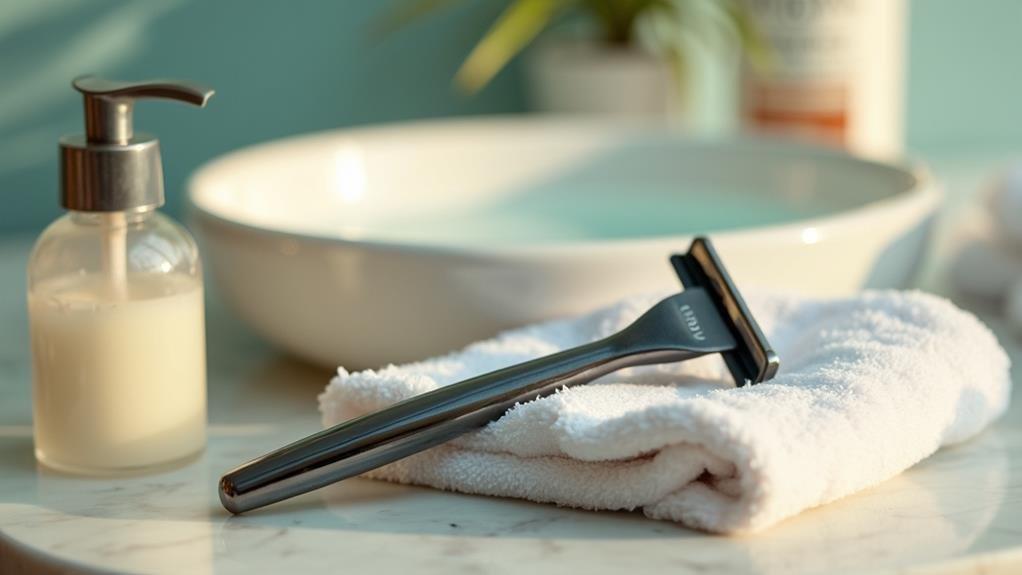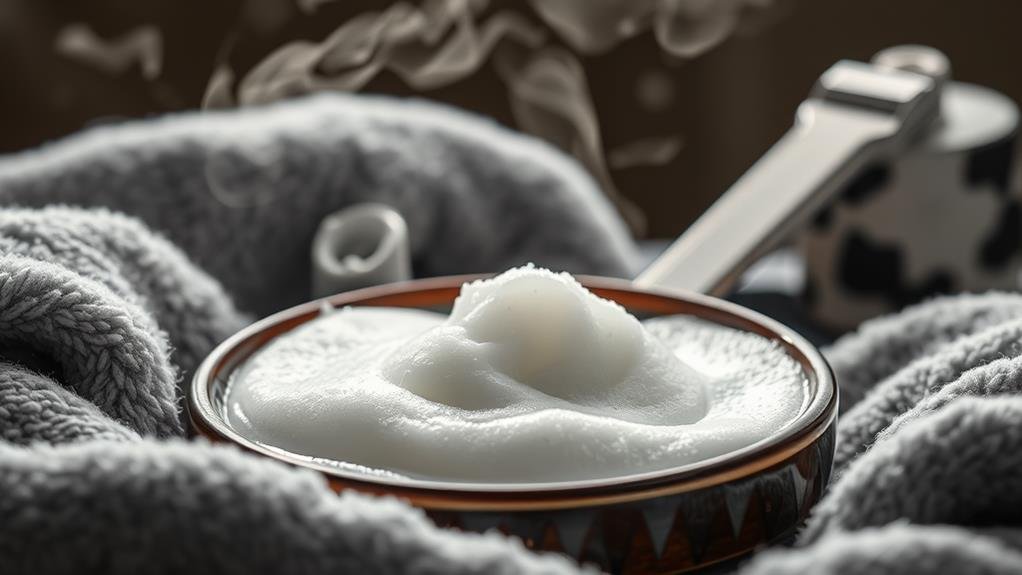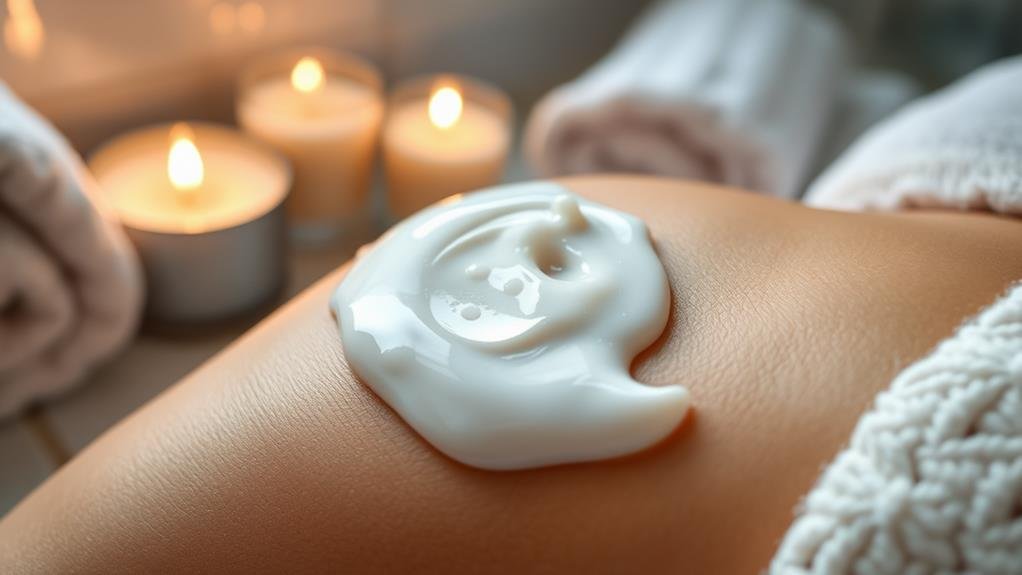
To avoid razor burn while shaving, start by choosing the right razor—opt for a sharp safety or single-blade razor. Prepare your skin by exfoliating and hydrating it with warm water to open pores. Use a quality shaving cream that's suitable for your skin type, with soothing ingredients like aloe vera. Always shave with the grain of your hair and apply light pressure to minimize irritation. Finally, moisturize your skin immediately after shaving to lock in hydration. With these strategies, you can enhance your shaving routine and mitigate discomfort, and there's plenty more to explore on this topic.
Key Takeaways
- Choose a safety razor or sharp disposable razor to minimize skin irritation and prevent tugging on hair.
- Properly prepare your skin by exfoliating and hydrating to reduce irritation and ensure a smooth shave.
- Use a high-quality shaving cream with soothing ingredients like aloe vera to create a protective barrier against friction.
- Always shave with the grain and use light pressure to avoid pulling and irritation from the blade.
- Moisturize immediately after shaving with a gentle, alcohol-free product to soothe the skin and lock in moisture.
Choose the Right Razor

Choosing the right razor is essential for minimizing the risk of razor burn. You need to consider various razor types, as each one offers distinct advantages and disadvantages. For instance, safety razors provide a balanced approach with a protective guard, reducing the likelihood of direct skin contact with the blade.
On the other hand, straight razors offer a closer shave but require more skill and practice to handle safely.
Blade sharpness plays a critical role in your shaving experience. Dull blades tug at the hair rather than slicing cleanly, leading to irritation and increased chances of razor burn. Ensure you're using a sharp blade that's designed for your skin type and hair texture.
If you're using disposable razors, replace them frequently to maintain optimal sharpness.
Additionally, consider the number of blades in a razor. Multi-blade systems can provide a smoother shave but may also increase the risk of irritation if not used correctly.
Ultimately, selecting the right razor type and ensuring blade sharpness are foundational steps in achieving a comfortable, irritation-free shave. Prioritize these factors to enjoy the freedom of smooth skin without the discomfort of razor burn.
Prepare Your Skin Properly
Before you shave, it's crucial to prepare your skin properly to minimize the risk of razor burn. A well-prepped surface helps ensure a smoother shave and reduces irritation.
Here are some essential steps to follow:
- Exfoliate skin: Use a gentle scrub or exfoliating glove to remove dead skin cells. This step prevents clogging your razor and allows for a closer shave.
- Hydrate skin: Apply a good moisturizer beforehand. Hydrated skin is more elastic and less prone to irritation during shaving.
- Warm water: Rinse your face with warm water or take a warm shower. The heat opens up pores, making hair removal easier.
- Soft cloth: Use a warm, soft cloth on the area you plan to shave. This can further relax your skin and prepare it for the razor.
Use Quality Shaving Cream

A quality shaving cream is essential for achieving a smooth, irritation-free shave. When selecting a shaving cream, consider your skin sensitivity and choose a product that caters to your specific needs. There are various shaving cream types available, including gel, foam, and cream formulations, each offering unique benefits. Gels typically provide a cool sensation and can be ideal for sensitive skin, while foams are lightweight and easy to apply.
When evaluating shaving cream, pay attention to the ingredients. Look for soothing components like aloe vera, chamomile, or shea butter, which can help calm irritation and provide additional moisture. Avoid products with harsh chemicals or fragrances, as these can exacerbate skin sensitivity and lead to razor burn.
Additionally, consider the thickness and consistency of the cream. A thicker cream often creates a protective barrier between your skin and the razor, reducing friction and the potential for irritation.
Ultimately, investing in a quality shaving cream tailored to your skin type can significantly enhance your shaving experience, allowing you to enjoy freedom from discomfort and irritation.
Shave With the Grain
Shaving with the grain is crucial for minimizing irritation and preventing razor burn. By following this technique, you can ensure a smoother shave while respecting the natural direction of hair growth. This not only reduces the risk of ingrown hairs but also enhances the overall comfort of your shaving experience.
Here are some effective tips for shaving with the grain:
- Identify the direction of your hair growth.
- Use light pressure to avoid tugging or pulling.
- Rinse your blade frequently to maintain its effectiveness.
- Consider using a single-blade razor for better control.
Understanding the natural growth pattern of your hair is key to achieving a successful shave. Different areas of your face or body may have varying directions, so take a moment to observe.
When you employ proper shaving techniques, you're less likely to experience irritation and discomfort. Always remember to adapt your approach based on the specific area you're shaving, as this can significantly impact your results.
Moisturize After Shaving

Even after mastering the technique of shaving with the grain, the importance of post-shave care can't be overlooked.
Moisturizing immediately after shaving is crucial for preventing irritation and promoting skin health. Your skin has just undergone a rigorous process, and applying a quality moisturizer can help restore its natural barrier.
Look for products specifically designed for post-shave care. These should contain soothing ingredients such as aloe vera, chamomile, or shea butter.
These elements not only provide immediate relief but also hydrate the skin, reducing the risk of razor burn. Avoid alcohol-based aftershaves, as they can exacerbate dryness and irritation.
When you apply your moisturizer, do so gently. Use a light, upward motion to avoid further irritating the freshly shaved skin.
Allow the product to absorb fully, which will lock in moisture and create a protective layer. This simple step can significantly enhance your shaving experience, leaving your skin feeling soft and rejuvenated.
Conclusion
To prevent razor burn, remember that nearly 80% of people experience it at some point in their shaving routine. By choosing the right razor, preparing your skin properly, using quality shaving cream, shaving with the grain, and moisturizing afterward, you can significantly reduce your chances of irritation. Implement these tips consistently, and you'll notice smoother, more comfortable results. Taking care of your skin is essential for a pleasant shaving experience, ensuring you look and feel your best.
